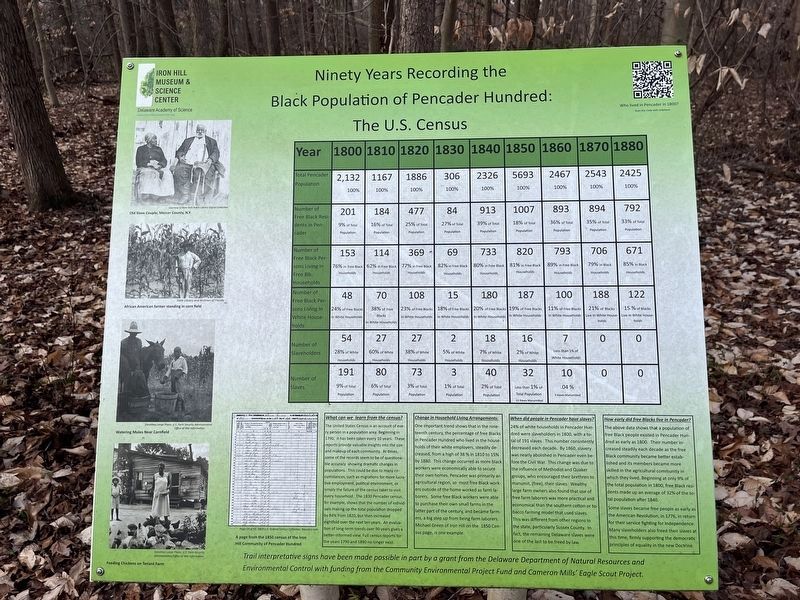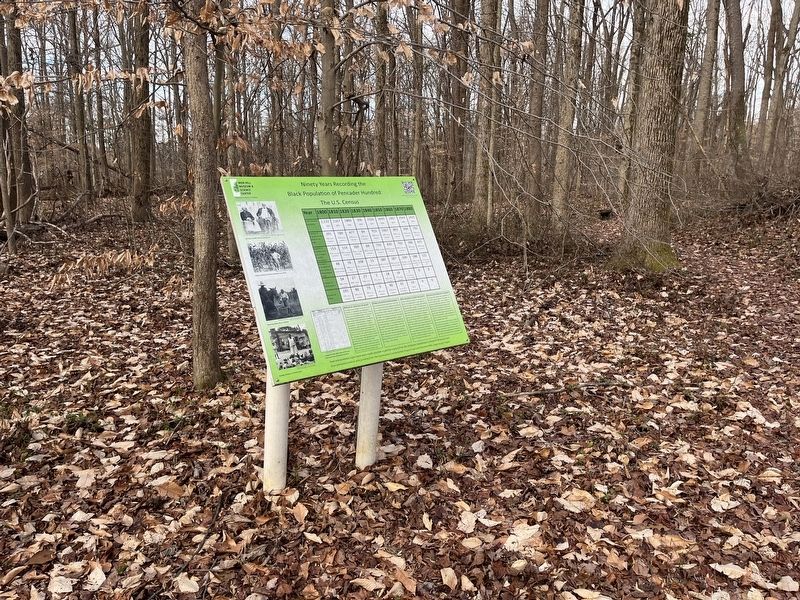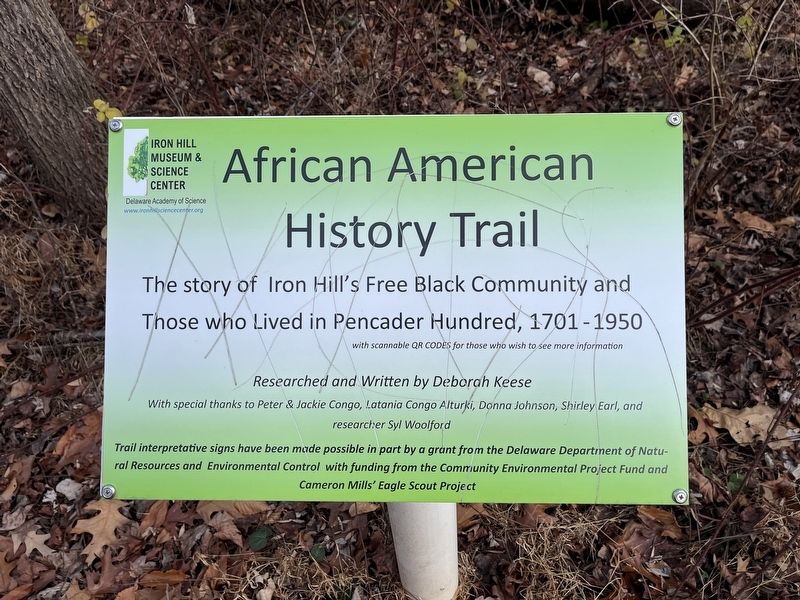Iron Hill Park near Newark in New Castle County, Delaware — The American Northeast (Mid-Atlantic)
Ninety Years Recording the Black Population of Pencader Hundred: The U.S. Census
Iron Hill Museum & Science Center
— Delaware Academy of Science —

Photographed By Devry Becker Jones (CC0), December 30, 2023
1. Ninety Years Recording the Black Population of Pencader Hundred: The U.S. Census Marker
1800Total Pencader Population: 2,132 100%1810
Number of Free Black Residents in Pencader:201 9% of Total Population
Number of Free Black Persons Living in Free Blk. Households: 153 76% of Free Black Households
Number of Free Black Persons Living in White Households: 48 24% of Free Blacks in White Households
Number of Slaveholders: 54 28% of White Households
Number of Slaves: 191 9% of Total PopulationTotal Pencader Population: 1167 100%1820
Number of Free Black Residents in Pencader: 184 16% of Total Population
Number of Free Black Persons Living in Free Blk. Households: 114 62% in Free Black Households
Number of Free Black Persons Living in White Households: 70 38% of Free Blacks in White Households
Number of Slaveholders: 27 60% of White Households
Number of Slaves: 80 6% of Total PopulationTotal Pencader Population: 1186 100%1830
Number of Free Black Residents in Pencader: 477 25% of Total Population
Number of Free Black Persons Living in Free Blk. Households: 369 77% of Free Black Households
Number of Free Black Persons Living in White Households: 108 23% of Free Blacks In White Households
Number of Slaveholders: 27 38% of White Households
Number of Slaves: 73 3% of Total PopulationTotal Pencader Population: 306 100%1840
Number of Free Black Residents in Pencader: 84 27% of Total Population
Number of Free Black Persons Living in Free Blk. Households: 69 82% in Free Black Households
Number of Free Black Persons Living in White Households: 15 18% of Free Blacks in White Households
Number of Slaveholders: 2 5% of White Households
Number of Slaves: 3 1% of Total PopulationTotal Pencader Population: 2326 10051850
Number of Free Black Residents in Pencader: 913 39% of Total Population
Number of Free Black Persons Living in Free Blk. Households: 733 80% in Free Black Households
Number of Free Black Persons Living in White Households:180 20% of Free Blacks in White HouseholdsPhotographed By Devry Becker Jones (CC0), December 30, 20232. Ninety Years Recording the Black Population of Pencader Hundred: The U.S. Census Marker
Number of Slaveholders: 18 7% of White Households
Number of Slaves: 40 2% of Total PopulationTotal Pencader Population: 5693 100%1860
Number of Free Black Residents in Pencader: 1007 18% of Total Population
Number of Free Black Persons Living in Free Blk. Households: 820 81% in Free Black Households
Number of Free Black Persons Living in White Households: 187 19% of Free Blacks In White Households
Number of Slaveholders: 16 2% of White Households
Number of Slaves: 32 Less than 1% of Total Population 13 Slaves ManumittedTotal Pencader Population: 2467 100%1870
Number of Free Black Residents in Pencader: 893 36% of Total Population
Number of Free Black Persons Living in Free Blk. Households: 793 89% in Free Black Households
Number of Free Black Persons Living in White Households: 100 11% of Free Blacks in White Households
Number of Slaveholders: 7 Less than 1% of White Households
Numberof Slaves: 10 .04% 3 Slaves ManumittedPhotographed By Devry Becker Jones (CC0), December 30, 20233. Entrance sign for the African American History TrailTotal Pencader Population: 2543 100%1880
Number of Free Black Residents in Pencader: 894 35% of Total Population
Number of Free Black Persons Living in Free Blk. Households: 706 79% in Black Households
Number of Free Black Persons Living in White Households: 188 21% of Blacks Live in White Households
Number of Slaveholders: 0
Number of Slaves: 0Total Pencader Population: 2425 100%
Number of Free Black Residents in Pencader: 792 33% of Total Population
Number of Free Black Persons Living in Free Blk. Households: 671 86% in Black Households
Number of Free Black Persons Living in White Households: 122 15% of Blacks Live in White Households
Number of Slaveholders: 0
Number of Slaves: 0
What can we learn from the census?
The United States Census is an account of every person in a population area. Beginning in 1790, it has been taken every 10 years. These reports provide valuable insights into the size and makeup of each community. At times, some of the records seem to be of questionable accuracy showing dramatic changes in populations. This could be due to many circumstances, such as migrations for lucrative employment, political environment, or simply the failure of the census taker to visit every household. The 1830 Pencader census, for example, shows that the number of individuals making up the total population dropped by 84% from 1820, but then increased eightfold over the next ten years. An evaluation of long-term trends over 90 years gives a better-informed view. Full census reports for the years 1790 and 1890 no longer exist.
Change in Household Living Arrangements:
One important trend shows that in the nineteenth century, the percentage of free Blacks in Pencader Hundred who lived in the households of their white employers, steadily decreased, from a high of 38% in 1810 to 15% by 1880. This change occurred as more black workers were economically able to secure their own homes. Pencader was primarily an agricultural region, so most free Black workers outside of the home worked as farm laborers. Some free Black workers were able to purchase their own small farms in the latter part of the century, and became farmers, a big step up from being farm laborers. Michael Green of Iron Hill on the 1850 census page, is one example.
When did people in Pencader have slaves?
24% of white households in Pencader Hundred were slaveholders in 1800, with a total of 191 slaves. This number consistently decreased each decade. By 1860, slavery was nearly abolished in Pencader even before the Civil War. This change was due to the influence of Methodist and Quaker groups, who encouraged their brethren to manumit, (free), their slaves. Wealthy large farm owners also found that use of free farm laborers was more practical and economical than the southern cotton or tobacco farming model that used slaves. This was different from other regions in the state, particularly Sussex County. In fact, the remaining Delaware slaves were one of the last to be freed by law.
How early did free Blacks live in Pencader?
The above data shows that a population of free Black people existed in Pencader Hundred as early as 1800. Their number increased steadily each decades as the free Black community became better established and its members became more skilled in the agricultural community in which they lived. Beginning at only 9% of the total population in 1800, free Black residents made up an average of 32% of the total population after 1840.
Some slaves became free people as early as the American Revolution, in 1776, in return for their service fighting for Independence. Many slaveholders also freed their slaves at this time, firmly supporting the democratic principles of equality in the new Doctrine.
Erected by Delaware Academy of Science.
Topics and series. This historical marker is listed in these topic lists: African Americans • Anthropology & Archaeology • Churches & Religion • Settlements & Settlers. In addition, it is included in the Quakerism series list. A significant historical year for this entry is 1800.
Location. 39° 37.884′ N, 75° 45.541′ W. Marker is near Newark, Delaware, in New Castle County. It is in Iron Hill Park. Marker can be reached from South Old Baltimore Pike east of Whittaker Road, on the right when traveling west. Touch for map. Marker is at or near this postal address: 1355 S Old Baltimore Pike, Newark DE 19702, United States of America. Touch for directions.
Other nearby markers. At least 8 other markers are within walking distance of this marker. The Iron Hill Community: Free Black Landowners (a few steps from this marker); What is the mound behind this sign? (a few steps from this marker); The Civil War 1861 - 1865 (within shouting distance of this marker); Iron Mining on Iron and Chestnut Hills, A Timeline (within shouting distance of this marker); Site of the First Iron Hill School (within shouting distance of this marker); Education for ALL, Past and Present: Iron Hill School, No. 112C / Iron Hill School #112C (within shouting distance of this marker); Historic Roads of Newark, Delaware / Petrified Log from Central Delaware (about 300 feet away, measured in a direct line); Iron Hill School #112-C (about 300 feet away). Touch for a list and map of all markers in Newark.
Credits. This page was last revised on January 8, 2024. It was originally submitted on December 31, 2023, by Devry Becker Jones of Washington, District of Columbia. This page has been viewed 66 times since then and 37 times this year. Photos: 1, 2, 3. submitted on December 31, 2023, by Devry Becker Jones of Washington, District of Columbia.

